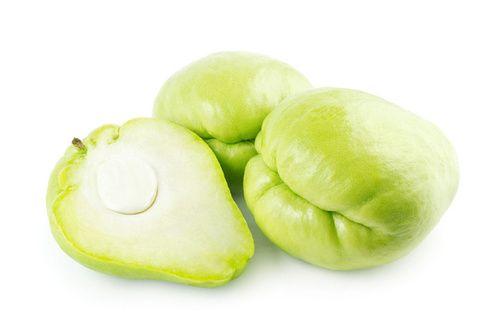Il squash, fruit native to Mexico, rich in amino acids, vitamin C, but above all Vitamin B9, is useful for the kidneys and the cardiovascular system. Let's find out better.
> Calories, nutritional values and properties of chayote
> Contraindications of chayote
> How to eat Chayote

Description of the fruit
Among the various interesting fruits of cucurbitacea of tropical origin it is impossible not to mention the chayote (Sechium edule), a relative of pumpkin, cucumber and various melons of Mexican origin, as evidenced by the Nahuatl word chayotil.
All parts of the plant are edible: the fruit, the leaves, the shoots, the tubers. The fruit has a green and firm pulp, with a consistency halfway between potato and cucumber, rich in water and rather sweet. There is a white variety on the market, known as "pirulero".
Chayote, ally of
Kidneys, cardiovascular system, bladder. Helps fight atherosclerosis, kidney stones and hypertension.
Calories, nutritional values and properties of chayote
100 grams of chayote contains 19 calories.
Furthermore, for 100 g of this product, we have:
- Lipids 0,1 g
- Cholesterol 0 mg
- Sodium 2 mg
- Potassium 125 mg
- Glucid 4,5 g
- Dietary fiber 1,7 g
- Sugar 1,7 g
- 0,8 g protein
- Vitamin C 7,7 mg
- Calcium 17 mg
- Iron 0,3 mg
- Magnesium 12 mg
The pulp and the seed are above all rich in amino acids, vitamin C, but above all vitamin B9, being one of the best plant sources. It also has good amounts of vitamins B6, B5 and K, and is a decent source of many metals, first of all zinc.
It is used in many local medicines because of the diuretic, anti-inflammatory, hypotensive properties. In the Western world it is indicated for the cleansing of the kidneys, in the diabetic diets, for the formation of the fetus in pregnant women, and is considered a food with anticancer properties.
You can learn more about the right nutrition to fight diabetes

Contraindications of chayote
None in particular: despite being called "thorny", its hair is not able to cause damage.
Curiosity
- The chayote has a long list of local names. The name is the Spanish version of a Nahuatl term which stands for "Peripheral fruit". Although related to the courgette, it is sometimes called "spiny eggplant". Along the lines of this name it can also be called "thorny courgette", "thorny gourd", "thorny pear". We also have the names "sechio" (from the scientific name), wolf language, "chow-chow", "pear-courgette", "pipinola".
- The seed has a peculiarity: it has no integument, it is separated from the pulp and is somehow "fused" to it. To preserve it, it is necessary to preserve the entire fruit.
How chayote is eaten
Following the conquest of Mexico by the Spaniards, chayote expanded throughout Latin America, reaching over the centuries also North America, Asia and Europe. Popular cuisines, especially the poorest ones, have added it to their recipes each in their own way.
Most recipes include consumption from cooked: stewed, roasted, fried, or better still sautéed quickly so as not to degrade the sweetish flavor and crunchy texture; it can be said that it is generally treated like a courgette.
Could be eaten raw without any problem, thus favoring the best intake of all its nutritional qualities, and is generally found finely chopped in salads dressed with lemon or lime. The sprouts are eaten like asparagus and the leaves like spinach. Tubers in Asia are used to fry them like potatoes.
READ MORE
The properties, benefits and contraindications of Cupuaçu
| Thestar.com


























